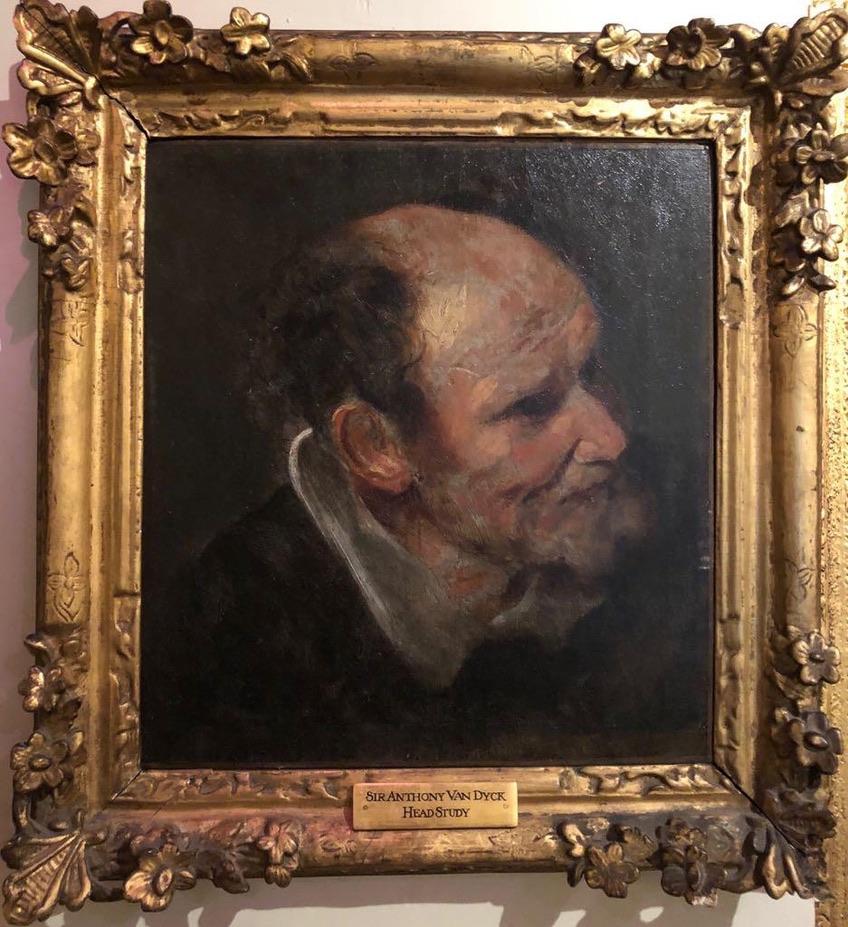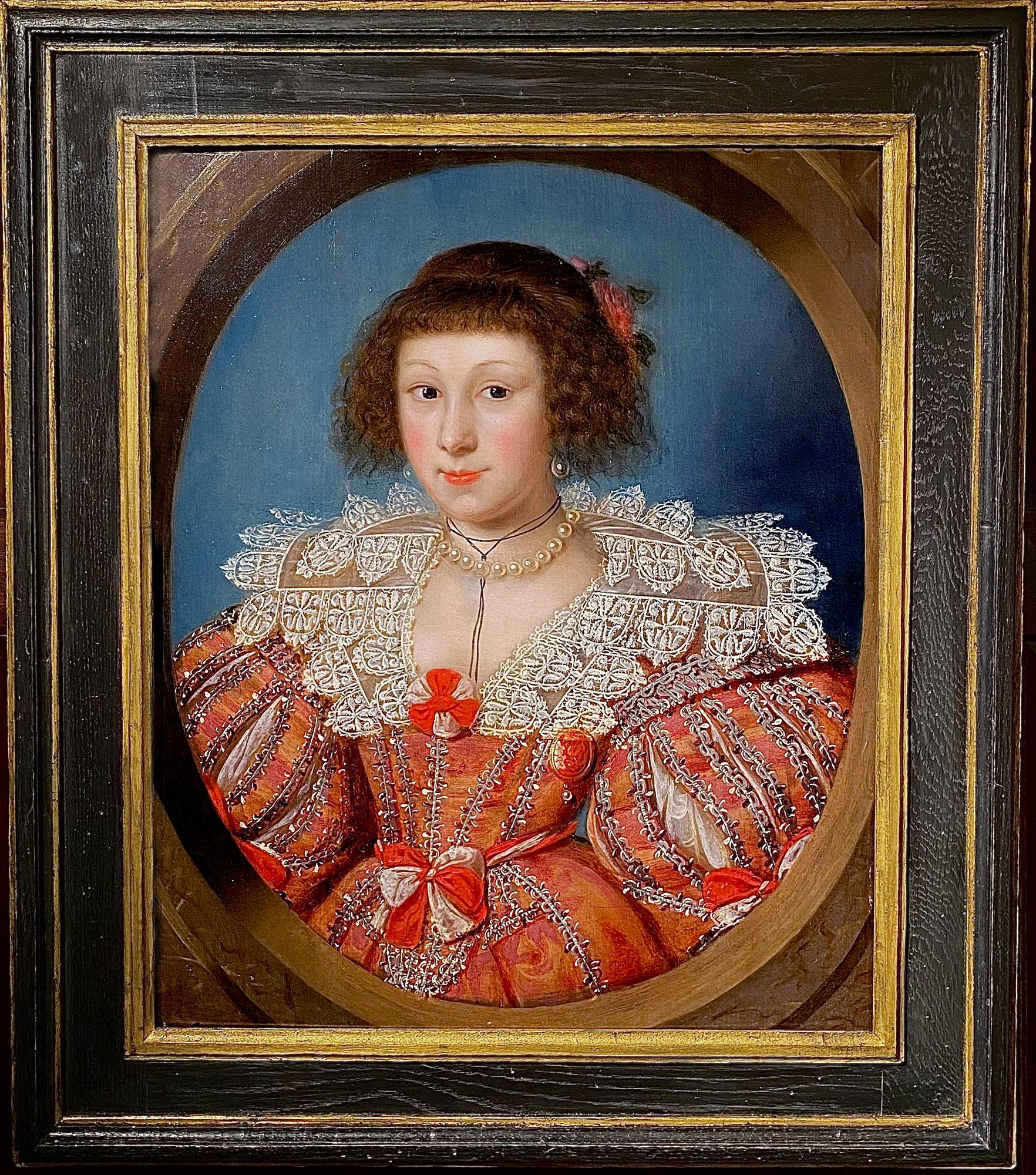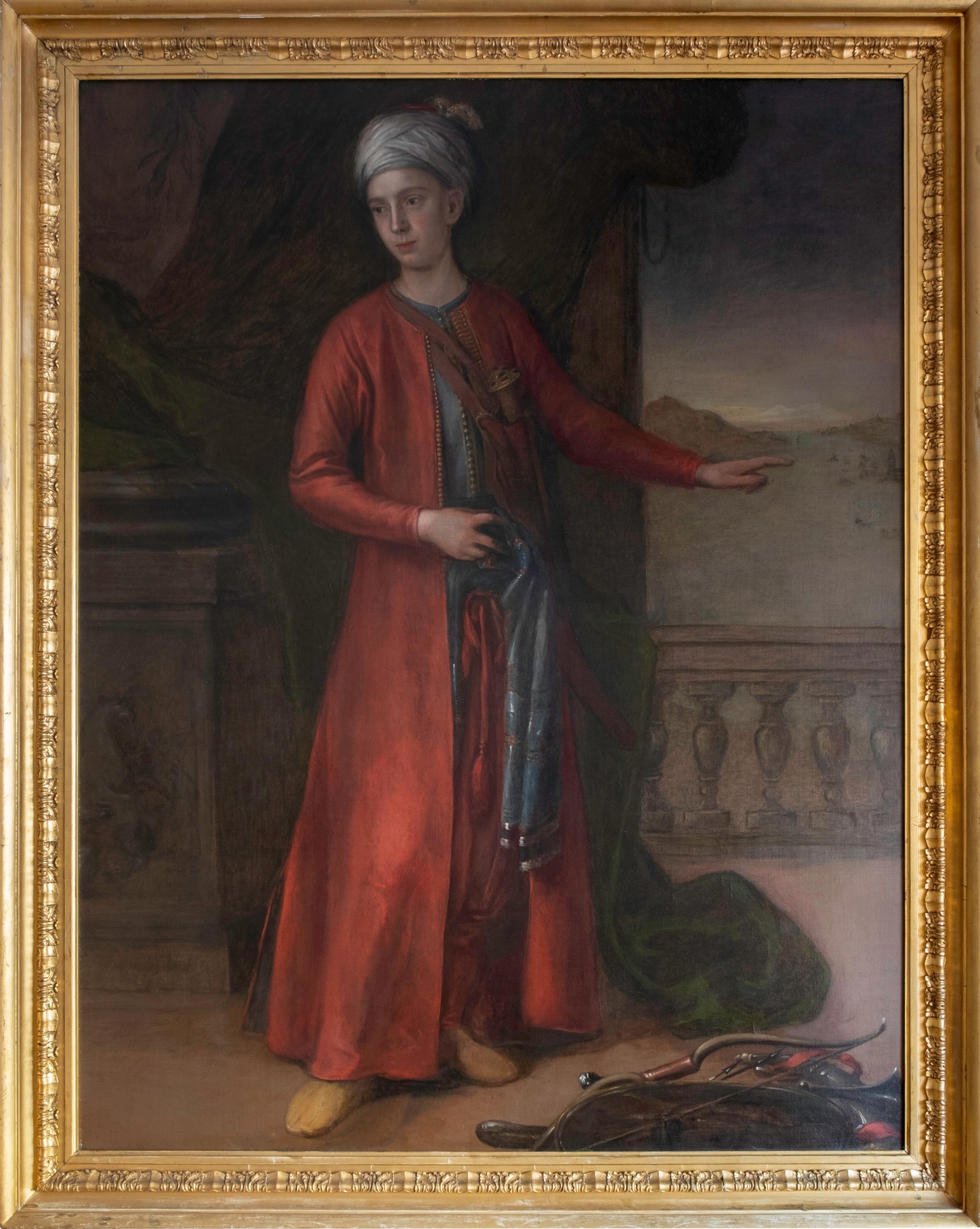Items Similar to Cupid Portrait Parmigianino Paint 17/18th Century Oil on canvas Old master Italy
Want more images or videos?
Request additional images or videos from the seller
1 of 15
Cupid Portrait Parmigianino Paint 17/18th Century Oil on canvas Old master Italy1650-1750
1650-1750
About the Item
Follower of FRANCESCO MAZZOLA, known as IL PARMIGIANINO (Parma, 1503 - Casalmaggiore, 1540)
Cupid Carving His Bow
(as the triumph of love and desire over reason and knowledge)
Oil on canvas
138 x 105 cm/ Framed 166 x 105 cm.
Reframed 19th century. Scattered retouches, excellent state of preservation.
Valuable gilded wooden frame with moulded edges from the end of the 19th century
Important painting depicting Cupid full-length intent on carving his bow, oil on canvas attributable to an artist who was a follower of Francesco Mazzola, known as Parmigianino, active between the 17th and 18th centuries.
The painting, which proves to be of excellent quality, is a study dedicated to the famous altarpiece depicting Cupid making his bow painted by Parmigianino in 1533/35 for the noble cavalier Francesco Baiardo, a friend and patron of the painter, now housed in the Kunsthistorisches Museum in Vienna (see the museum's official website for details).
This complex iconography and the way it is depicted have made the painting an extraordinary example of the artist's ingenuity and refinement. Indeed, his contemporaries recognised the beauty of style and refinement of line that characterised his works.
For these reasons, the work enjoyed enormous popularity and exerted a profound and lasting influence, as demonstrated by the fact that over the years it was copied and taken as a model by numerous artists. More than 50 copies can be counted, the most illustrious of which are Joseph Heintz the Elder's and Rubens' 1614 copy, which is kept at the Alte Pinakothek in Munich [1].
The painting depicts the young Cupid who, occupying the entire scene, tall and narrow to perfectly frame his statuesque body, is intent on making the bow with which he shoots his arrows of love.
He is depicted not as a child but as an adolescent, an aspect that was deliberately intended to lend a more sensual character to the composition: the figure conceived by Parmigianino was certainly inspired by the ancient Hellenistic sculptures depicting the young man.
Cupid turns around and looks seductively at the viewer, disrespectfully pointing his left leg at two books to support the arch, symbolising the triumph of love and desire over reason and knowledge.
Attention to the lower half of the painting is drawn to the two putti glimpsed between Cupid's legs, locked in an embrace. The little boy, who is winged, directs a look of mischievous complicity at the viewer, forcefully clutching the little girl, who tries to rebel in a grimace of rage, and grasps her right wrist as if directing her to touch Cupid, that is, to submit to Love.
The two children are identified as the snares of unrequited love, which Cupid himself will soon placate with one of his arrows. Various interpretative hypotheses have been formulated on the pair of cupids: Anteros and Liseros (respectively the masculine impulse that gives strength to love and the feminine principle that counteracts its vehemence), or Sacred Love and Profane Love.
The characteristics of the pictorial draftsmanship suggest a date between the 17th and 18th centuries and the author is certainly to be sought among the various followers who, looking to the Parma master as an example of style, replicated some very successful models and were therefore in great demand among the prestigious patrons of the time.
ADDITIONAL INFORMATION:
The work is sold complete with a gilded wooden frame and comes with a certificate of authenticity and descriptive iconographic card.
We take care of and organise the transport of the purchased works, both for Italy and abroad, through professional and insured carriers.
It is also possible to see the painting in the gallery in Riva del Garda, we will be happy to welcome you to show you our collection of works.
Contact us, without obligation, for any additional information.
- Creation Year:1650-1750
- Dimensions:Height: 65.36 in (166 cm)Width: 41.34 in (105 cm)
- Medium:
- Movement & Style:
- After:Francesco Mazzola, Known As Il Parmigianino (parme, 1503 - 1540)
- Period:
- Condition:
- Gallery Location:Riva del Garda, IT
- Reference Number:1stDibs: LU988114071352
About the Seller
4.8
Platinum Seller
These expertly vetted sellers are 1stDibs' most experienced sellers and are rated highest by our customers.
Established in 2017
1stDibs seller since 2018
202 sales on 1stDibs
Typical response time: <1 hour
- ShippingRetrieving quote...Ships From: Riva del Garda, Italy
- Return PolicyA return for this item may be initiated within 7 days of delivery.
More From This SellerView All
- Christ Salvator Mundi Paint Oil on copper 16/17th Century Flemish schoolLocated in Riva del Garda, ITAntique painting depicting the Face of Christ as Salvator Mundi Flemish painter, 16th-17th century Oil on copper 22 x 18 cm./ framed 42 x ...Category
16th Century Old Masters Paintings
MaterialsOil
- Deposition Atala De Roussy-trioson Paint Oil on canvas 19/20th Century FrenchLocated in Riva del Garda, ITThe deposition of Atala Follower of Anne-Louis Girodet de Roussy-Trioson (Montargis, 1767 - Paris, 1824) 19th-20th century Oil on canvas 47 x 65 cm. - Framed 67 x 84 cm The propos...Category
Late 19th Century Old Masters Paintings
MaterialsOil
- Perroneau Portrait Lady Woman Paint Oil on canvas 18th Century Old master FrenchLocated in Riva del Garda, ITJean-Baptiste Perroneau (Paris, 1715 – Amsterdam, 1783) Portrait of a lady Oil on oval canvas 60 x 50 cm. - In frame 77 x 66 cm. Work accompanied by expertise: Raffaelle Colace (Cremona), Ferdinando Arisi Reference bibliography: d’Arnoult, Dominique (2014) Jean-Baptiste Perronneau, c 1715-1783, un portraitiste dans l’Europe des Lumières Excerpt from the expertise of Dr. Colace: This refined portrait of a lady is a perfect example of the style of Jean-Baptiste Perroneau, a very talented French painter, whose most beautiful works are located, just like this one, between the fifth and sixth decades of the eighteenth century. "Perroneaeu is more naturally colored than La Tour, the est, in the peinture de poussière colorée, tout plein de tons clairs, frais, presque humides": this is how his brothers wrote about him in La Maison d...Category
18th Century Old Masters Paintings
MaterialsOil
- Terwesten Woman Allegory Art Paint Oil on canvas 17/18th Century Old masterLocated in Riva del Garda, ITMattheus Terwesten (The Hague, 1670 - 1757) Portrait of a young woman with palette and brushes, as Allegory of the art of Painting Oil on canvas 160 x 91 cm. - In frame 178 x 107 cm...Category
17th Century Old Masters Paintings
MaterialsOil
- Portrait Knight Paint Oil on canvas 17th Century Lombard school Old master ItalyLocated in Riva del Garda, ITLombard painter of the 17th century Portrait of a Knight in Armour Oil on canvas 81 x 70 cm./ Framed 93 x 82 A handsome gentleman in armour, immortalised in an authoritative and pr...Category
17th Century Old Masters Paintings
MaterialsOil
- Portrait Noblewoman Dog Van Loo Paint 18th Century Oil on canvas Old master ArtLocated in Riva del Garda, ITLouis Michel van Loo (Toulon 1707- Paris 1771) attributable Portrait of a noblewoman with her little dog Oil on canvas (79 x 66 cm. - with frame 92 x 78 cm.) A qualitative portrait depicting an elegant noblewoman of French origin, presumably belonging to the wealthy court of Versailles during the reign of Louis XV; this work fully reflects the pictorial qualities as well as the refinement of the compositional style of the French painter Louis Michel van Loo (1707- 1771), one of the most significant portrait painters of his time, and for this reason in demand at the most noble European courts. The work, taking up the traditional formula for portraits of members of the aristocracy, shows the effigy in a half-length pose, slightly turned to the right and looking directly at the viewer. The woman, with a regal bearing, is here portrayed intent on completing her daily beauty ritual, wearing a cape during her make-up, which must have just been completed as pink powder is visible on her cheeks. This luxurious garment reveals a corset with a daring neckline, made of silk and lace, and a coral-coloured dress ending in wide jabote cuffs. Her hair is styled in the French fashion in a hairstyle that highlights her facial features. Having finished her beauty ritual, the woman is intent on removing her cape with one hand, an elegant gesture that emphasises her noble pose. At her side is her small pet dog, sitting on a blue velvet cushion with gold trim. The canvas may have been made on the occasion of a wedding, elegantly celebrating the role of a member of the aristocracy. The presence of the pet depicted in her arms had in fact a precise meaning: the fidelity that is such a well-known characteristic of the dog, declared at the same time the virtues of the effigy. Louis Michel van Loo (Toulon 1707- Paris 1771) was the son of the painter Jean Baptiste van Loo, with whom he studied in Rome and Turin. He attended the Paris Academy, where he won the first prize for painting in 1726. In 1728 he returned to Rome, where he met Francois Boucher. In 1732, passing through Turin, he returned to Paris. In 1737 van Loo became court painter in Madrid, succeeding Jean Ranc...Category
18th Century Old Masters Paintings
MaterialsOil
You May Also Like
- Portrait of a Lady with a ChiqueadorLocated in New York, NYProvenance: Torres Family Collection, Asunción, Paraguay, ca. 1967-2017 While the genre of portraiture flourished in the New World, very few examples of early Spanish colonial portraits have survived to the present day. This remarkable painting is a rare example of female portraiture, depicting a member of the highest echelons of society in Cuzco during the last quarter of the 17th century. Its most distinctive feature is the false beauty mark (called a chiqueador) that the sitter wears on her left temple. Chiqueadores served both a cosmetic and medicinal function. In addition to beautifying their wearers, these silk or velvet pouches often contained medicinal herbs thought to cure headaches. This painting depicts an unidentified lady from the Creole elite in Cuzco. Her formal posture and black costume are both typical of the established conventions of period portraiture and in line with the severe fashion of the Spanish court under the reign of Charles II, which remained current until the 18th century. She is shown in three-quarter profile, her long braids tied with soft pink bows and decorated with quatrefoil flowers, likely made of silver. Her facial features are idealized and rendered with great subtly, particularly in the rosy cheeks. While this portrait lacks the conventional coat of arms or cartouche that identifies the sitter, her high status is made clear by the wealth of jewels and luxury materials present in the painting. She is placed in an interior, set off against the red velvet curtain tied in the middle with a knot on her right, and the table covered with gold-trimmed red velvet cloth at the left. The sitter wears a four-tier pearl necklace with a knot in the center with matching three-tiered pearl bracelets and a cross-shaped earing with three increasingly large pearls. She also has several gold and silver rings on both hands—one holds a pair of silver gloves with red lining and the other is posed on a golden metal box, possibly a jewelry box. The materials of her costume are also of the highest quality, particularly the white lace trim of her wide neckline and circular cuffs. The historical moment in which this painting was produced was particularly rich in commissions of this kind. Following his arrival in Cuzco from Spain in the early 1670’s, bishop Manuel de Mollinedo y Angulo actively promoted the emergence of a distinctive regional school of painting in the city. Additionally, with the increase of wealth and economic prosperity in the New World, portraits quickly became a way for the growing elite class to celebrate their place in society and to preserve their memory. Portraits like this one would have been prominently displayed in a family’s home, perhaps in a dynastic portrait gallery. We are grateful to Professor Luis Eduardo Wuffarden for his assistance cataloguing this painting on the basis of high-resolution images. He has written that “the sober palette of the canvas, the quality of the pigments, the degree of aging, and the craquelure pattern on the painting layer confirm it to be an authentic and representative work of the Cuzco school of painting...Category
17th Century Old Masters Paintings
MaterialsCanvas, Oil
- Portrait of Senator Bartolomeo Panciatichi by Santi di Tito (1574)Located in PARIS, FRThis recently rediscovered portrait of Santi di Tito depicts a Florentine senator, with a letter in his hand indicating that the painting was executed in 1574 when the sitter was 66 years old. On the basis of these clues, it is tempting to view it as a portrait of Bartolomeo Panciatichi, who was painted some thirty years before by Bronzino (1503 - 1572). While the treatment of the hands recalls the Florentine tradition of Mannerist portraits, the comparison with Bronzino's portrait illustrates Santi di Tito's search for greater realism, despite the stereotyped composition. 1. Santi di Tito, Counter-Reformation painter and portraitist Santi di Tito was the great painter of the Florentine Counter-Reformation. He proposed a new artistic language that broke away from Mannerism. Little is known about his training in Florence (perhaps alongside Bronzino or Baccio Bandinelli), but this period of training enabled him to join the Company of Saint Luke, the guild of Florentine painters, in 1554. Between 1560 and 1564, Santi di Tito spent time in Rome, where he frequented the workshop of Taddeo Zuccari. This stay had a fundamental influence on his work, thanks to the discovery of the late work of Raphael, but also his encounters with the painters Francesco Salviati and Federico Barocci. Around 1565, Santi di Tito returned to Florence, where he remained until the end of his life, dividing his talents between the creation of important religious paintings and countless portraits. He became one of the city's leading painters, distinguishing himself, in particular, in the creation of large religious compositions in which the spirit of the Counter-Reformation was reflected. In 1568, Santi di Tito became a member of the Confraternity of Saint Thomas Aquinas...Category
16th Century Old Masters Portrait Paintings
MaterialsPoplar, Oil
- Stunning 17th Century Oil Painting - Study of a Head of a ManBy Anthony van DyckLocated in London, GBStudio of Sir Anthony Van Dyck (1599-1641, Flemish) Study of a Head of Man Circa 1627-32, Van Dyck’s second Antwerp period Oil on paper, laid down on canvas Dimensions 15 x 14 inches...Category
17th Century Old Masters Portrait Paintings
MaterialsOil
- Portrait of a Girl, 17th Century English School Old Masters OilBy Gilbert JacksonLocated in London, GBGilbert Jackson English Active: 1620 - 1650 Portrait of a Girl Oil on panel, signed upper left and Inscribed upper right Image size: 24 ½ x 20 inches Contemporary style hand made...Category
17th Century Old Masters Portrait Paintings
MaterialsOil
- 18th C. Portrait of the 4th Earl of Sandwich a View of Constantinople BeyondLocated in London, GBJohn Montagu, 4th Earl of Sandwich (13 November 1718 – 30 April 1792) Attributed to George Knapton (1698-1778) Dressed in the Turkish manner, stand...Category
18th Century Old Masters Figurative Paintings
MaterialsOil
- Italian Greyhound and Friends - Italian 17thC Old Master dog art oil paintingBy Francesco FieravinoLocated in London, GBThis stunning Old Master 17th century oil portrait painting is attributed to Francesco Fieravino, an artist famous in his day for still lifes and carpets. This painting which dates t...Category
17th Century Old Masters Animal Paintings
MaterialsCanvas, Oil
Recently Viewed
View AllMore Ways To Browse
Genevieve May
Bob Ross Painting Original
Moltitudine Roberta Pinna
Pauline Bliss Williams
Pierre Yves Leduc
Real Real Dinner Plates Animal
California Impressionist Art
South African Art
All Over Heart
Prince Purple
Echo Park Los Angeles
19th Century French Academy Study Drawing
Ideal Landscape British
Flemish Painting 17th C
Sellers In Philadelphia
Sante Fe Art Galleries
Immaculate Conception Painting
Joseph Cave





